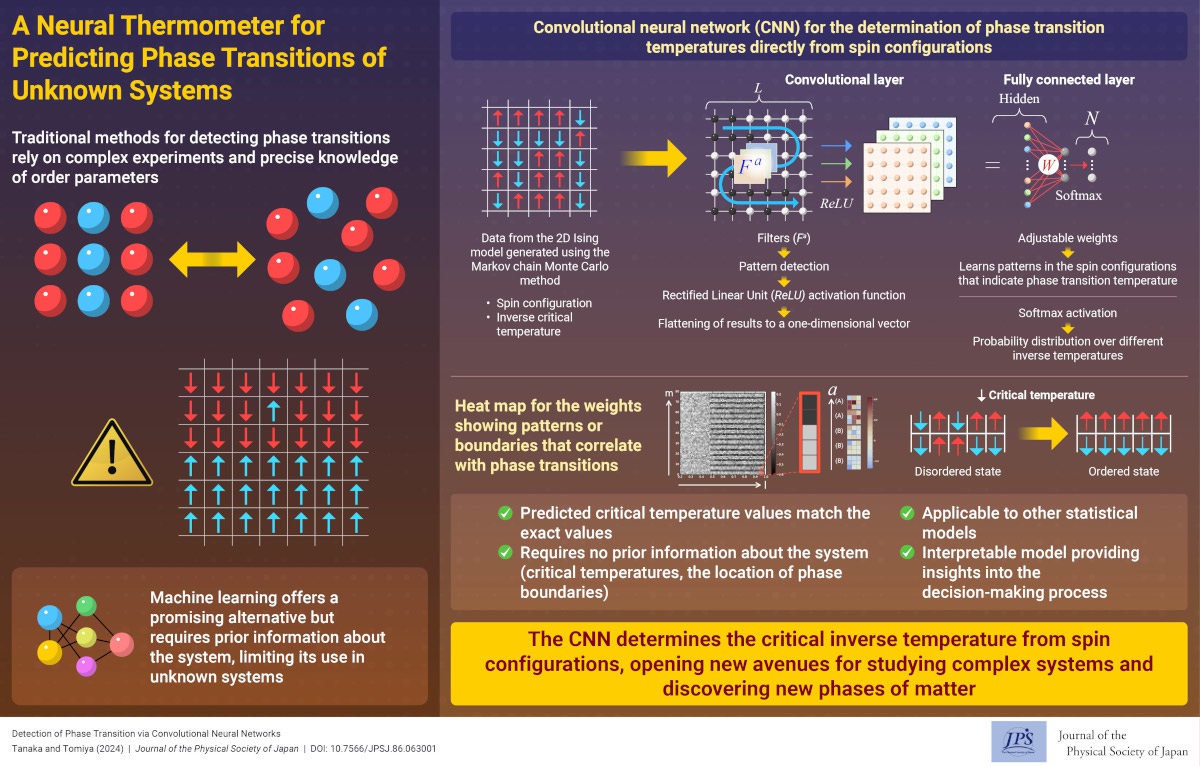A Neural Thermometer for Predicting Phase Transitions of Unknown Systems
© The Physical Society of Japan
This article is on
Detection of Phase Transition via Convolutional Neural Networks
(The 29th Outstanding Paper Award of the Physical Society of Japan)
J. Phys. Soc. Jpn. 86, 063001 (2017).
A novel convolutional neural network predicts phase transition temperatures from spin configurations without prior information about order parameters, paving the way for the discovery of new materials in condensed matter physics.

Machine learning has revolutionized research in fields hindered by experimental limitations. One notable application is identifying phases of matter that are classified by order parameters, which measure the degree of order within a system and signal phase transitions. These transitions can range from simple solid-liquid transformations to complex changes in magnetization or superconductivity. Identifying order parameters requires precise measurements that are often challenging with current technology. Additionally, some phases, like topological phases, lack clear order parameters, making them difficult to analyze.
Convolutional neural network (CNN)-based machine learning techniques have successfully classified phases in two- and three-dimensional systems. However, these techniques require labeled data, such as known phases or critical temperatures where phase transitions occur, to identify patterns and train the model. This limitation restricts their use for studying unknown systems, where information is not readily available.
In our study, we developed a novel CNN to determine phase transition temperatures directly from spin configurations of the system. The CNN consists of a convolutional layer that extracts patterns from the spin configurations, a single hidden layer, and a fully connected layer for (inverse) temperature prediction. We trained the CNN on data generated from the 2D Ising model, a simplified model of a magnetic system where spins are aligned either up or down on a 2D grid or lattice. In such a system, the spins tend to align below the critical temperature (the phase transition temperature), resulting in a magnetized phase. Using data generated through Monte Carlo simulations of the Ising model, the weights in the trained neural network captured features of the various spin configurations that signal phase transitions, enabling accurate prediction of critical temperatures.
Our model's predictions of ferromagnetic phase transition temperatures closely matched the exact solutions. Although we used data generated by the Monte Carlo method for training, the model can also be applied to real data. The model is unique in that even though it was trained to just predict the (discretized) inverse temperatures of the inputs, it acquired the notion of phase transition coincidentally. This makes it particularly useful for studying completely unknown systems and statistical models in condensed matter physics. Additionally, unlike many neural networks that operate as black boxes and do not explain their predictions, this model provides insight into how it reaches its decisions in predicting critical temperatures, making it valuable for system analysis. For these contributions, our study received the Outstanding Paper Award from the Physical Society of Japan.
Detection of Phase Transition via Convolutional Neural Networks
(The 29th Outstanding Paper Award of the Physical Society of Japan)
J. Phys. Soc. Jpn. 86, 063001 (2017).
Share this topic
Fields
Related Articles
-
Solving a Stochastic Differential Equation is Solving a Mean-Field Quantum Spin System
Statistical physics and thermodynamics
Mathematical methods, classical and quantum physics, relativity, gravitation, numerical simulation, computational modeling
Magnetic properties in condensed matter
2024-5-16
The replica method maps matrix-valued geometric Brownian motion to a mean-field quantum spin system. This correspondence makes it possible to obtain an exact solution for matrix-valued geometric Brownian motion.
-
Thermodynamic Property of a CMOS Device beyond Landauer Limit
Statistical physics and thermodynamics
Electronic transport in condensed matter
Cross-disciplinary physics and related areas of science and technology
2024-1-23
Focusing on a CMOS NAND GATE operating in a sub-threshold region, the thermodynamic cost of computation was analyzed in relation to input/output voltages surpassing the Landauer limit.
-
Exploring Recent Advances in the Physics of Biofluid Locomotion
Measurement, instrumentation, and techniques
Cross-disciplinary physics and related areas of science and technology
Electromagnetism, optics, acoustics, heat transfer, and classical and fluid mechanics
Statistical physics and thermodynamics
Mathematical methods, classical and quantum physics, relativity, gravitation, numerical simulation, computational modeling
Structure and mechanical and thermal properties in condensed matter
2023-12-8
This Special Topics Edition of the JPSJ describes the latest advances in the field of biofluid locomotion, shedding light on the underlying physics behind the movement of organisms that swim and fly.
-
Discovering a Local Fluctuation Theorem with Machine Learning
Fundamental Theory of Condensed Matter Physics, Statistical Mechanics, Fluid Dynamics,
Statistical physics and thermodynamics
Measurement, instrumentation, and techniques
2023-10-20
A groundbreaking study reveals a new time-local fluctuation theorem using machine learning, revolutionizing our understanding of deterministic nonequilibrium steady state systems.
-
Net-Pattern of Muskmelon Rind Favors a Common Mathematical Law
Cross-disciplinary physics and related areas of science and technology
Statistical physics and thermodynamics
2023-1-12
The surface of muskmelon is covered with a fine mesh-like net-pattern. The geometric features of the fine mesh appear unique for each individual, but hide an unexpected mathematical rule.
